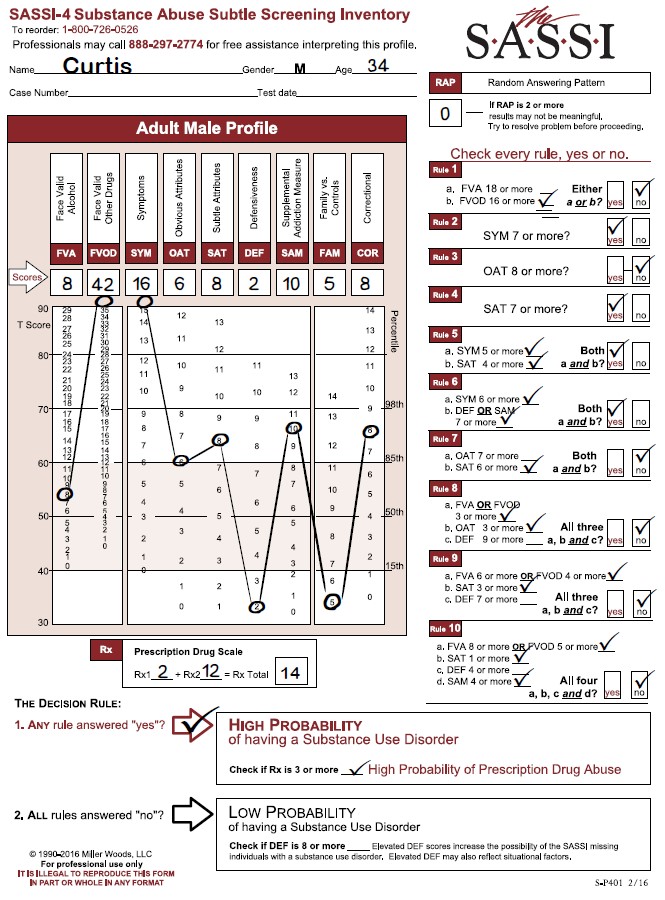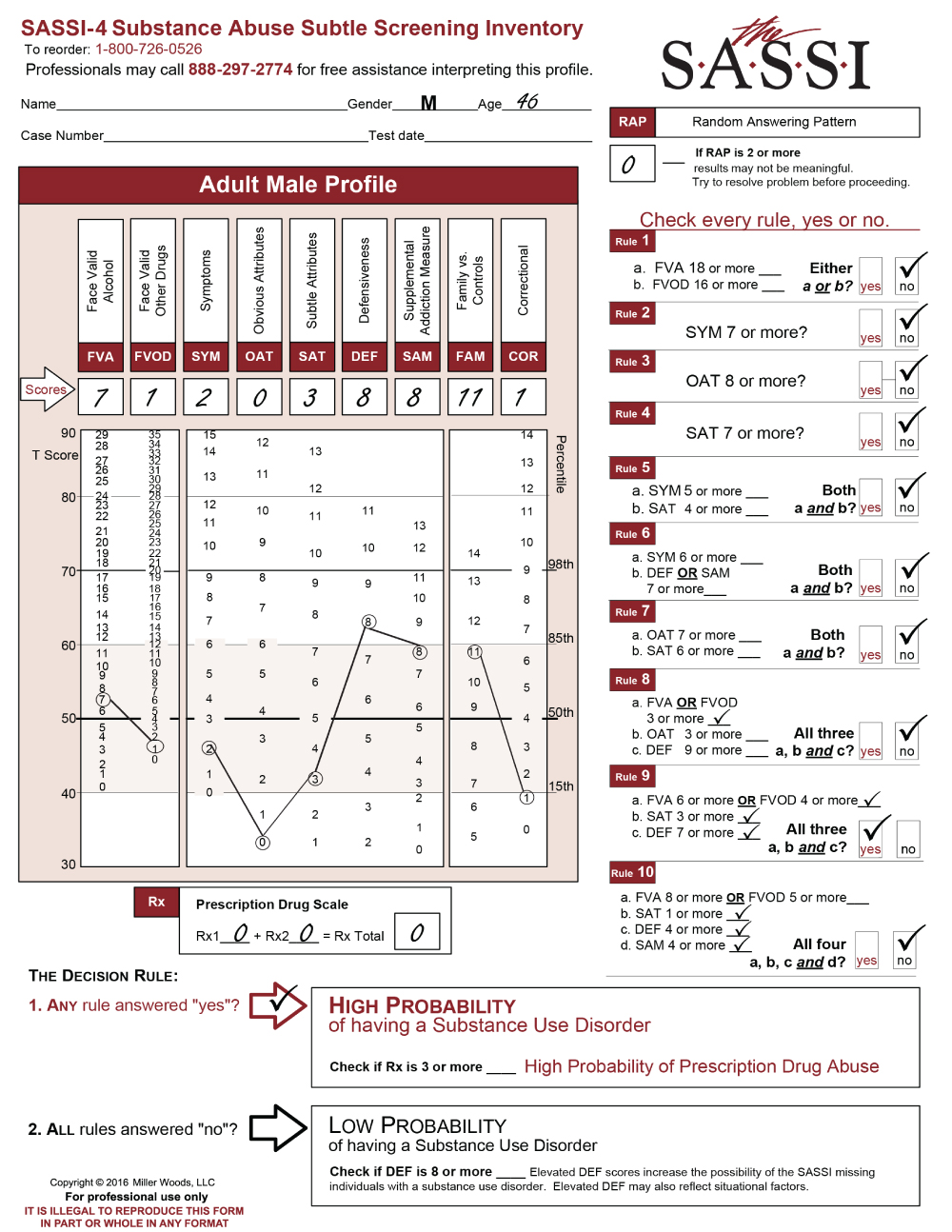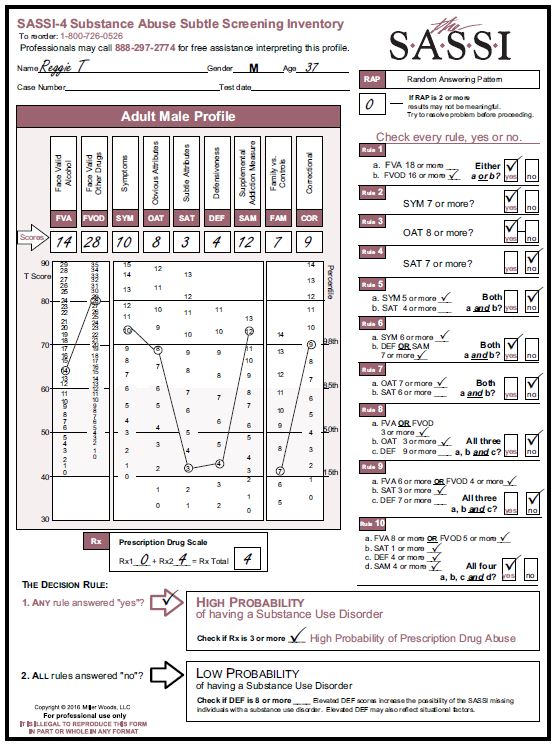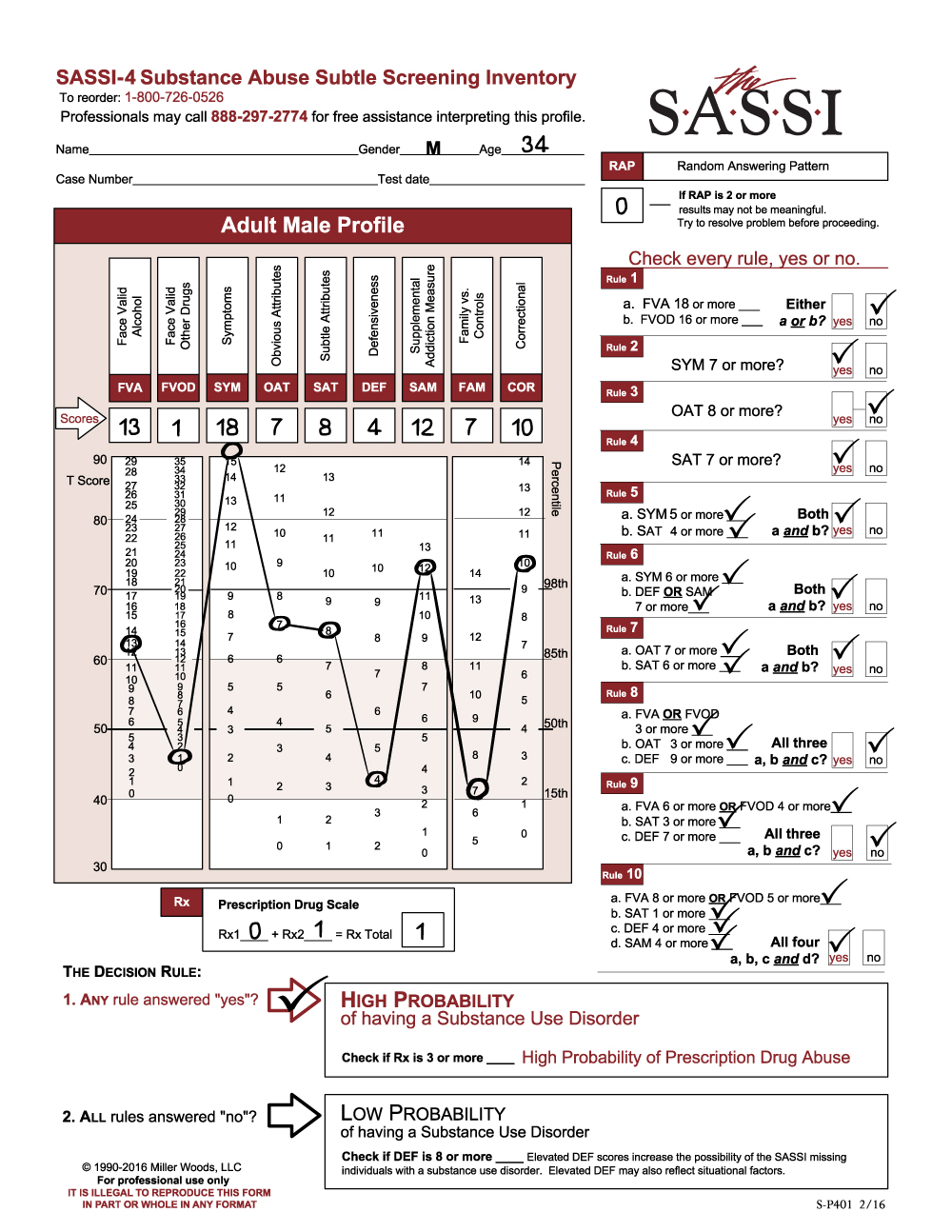In this edition of SASSI Online Tips and Tricks we highlight setting up a questionnaire and the delivery options. When administering a questionnaire, you have six options. This volume will cover the first five in depth. The last one, SASSI to Go, will get its own volume, so watch for that!
Tag: SASSI-4
SASSl-4 Profile Analysis – DOT Client
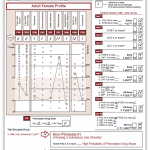
We frequently receive calls requesting clinical interpretation of profiles done on Department of Transportation (DOT) clients. These clients have failed their drug/alcohol screening and their license to drive has been suspended pending an evaluation. In this particular case, the client is a 68-year-old female whose alcohol level registered above the DOT threshold. Her SASSI result indicated a high probability of a substance use disorder based on Rule 9. As you see on the graph, most of the scale’s clinical results fall within the norm. DEF, at 11, is above the 98th percentile and FAM, at 12 is above the 85th percentile. The OAT score of 1 falls in the 15th percentile. The high-DEF score is not unusual in DOT evaluations. It is incumbent on the evaluator to determine what the defensiveness is about. The SAM scale is no help in this case because it is not elevated. An elevated DEF coupled with an elevated SAM indicates the defensiveness is related to substance use. The elevated FAM score indicates someone who is not comfortable looking at their own issues. And the low OAT score indicates someone who has difficulty acknowledging their personal limitations and shortcomings. The combination of these three scales provides information to the evaluator that most likely, this client is not going to be forthcoming in disclosing issues or problems. During the evaluation, another piece of information disclosed was the client’s admission of trying to manage or monitor her drinking to try to stay below DOT’s threshold of alcohol use. That certainly may be a red flag.

Since the SASSI is a screening inventory and does not diagnose, the evaluator needs to reference the DSM-5 to determine if, indeed, the client meets the criteria for a substance use disorder and if so, what level – mild, moderate, or severe. Based on that, the evaluator has a couple of options to consider. If possible, work individually or refer to an individual substance abuse counselor to establish rapport and work to get the defensiveness down. Motivational Interviewing is a good asset to pull out in this case. Another option is to refer her to an outpatient group setting with the goal of connecting her to other clients and also have access to individual counseling as well. Regardless, outpatient treatment seems to be the most likely intervention.
It would be helpful to acknowledge the financial impact on the client that suspension of driving privileges is having on her. That certainly could be triggering the extreme defensiveness we see in the results and the consequences for the client could be significant.
We hope these reviews are helpful and whether you are a new user or a very experienced one,
clinicians are here to help with any questions you might have. Clinicians are available M-F, 11-5 (EST). Call us at 800-726-0526 or 888-297-2774.
Addressing the Ethical Issues of Mandated Client
This sample profile is about a 27-year-old, Sally, who is a single mother of two small children. Sally was ordered by the court to report for a substance abuse assessment following an arrest for illegal possession of a controlled substance. Sally is also being investigated by the county’s Child Protective Services Agency, who has placed her children into foster care pending the outcome of the case.
An initial review of Sally’s scores indicates that, although she apparently understood the SASSI items and most likely responded in a meaningful way (RAP=1), there is evidence of significant defensive responding (DEF=9). Despite her defensiveness, the results indicate that she has a high probability of having a substance use disorder (SUD) based on Decision Rule 8 and 9. To put it another way, there is a 93% chance that Sally will meet the DSM-5 diagnostic criteria for having a substance use disorder once a more comprehensive evaluation is completed.
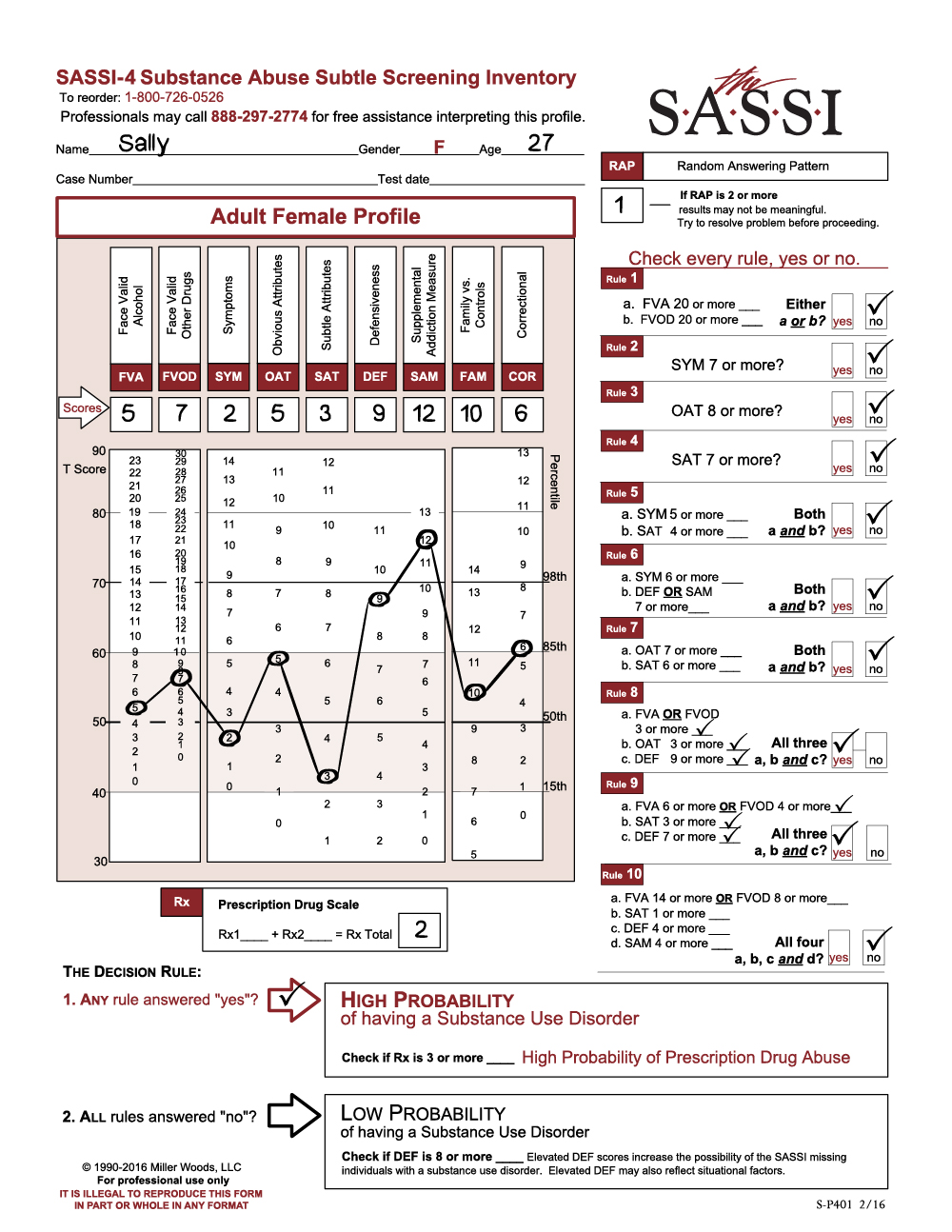
For now, however, the SASSI has provided us with important information concerning Sally’s illegal act; her behavior is likely to be related to a serious addiction problem. In this light, we can now shift to looking for additional features on her profile that might help us to understand Sally better and develop a more empathic point of view. Learning more about her perspective and how she is dealing with this entire process, including the new information from the SASSI, certainly is one way to provide supportive and effective care to her during a mandated process of evaluation.
A prominent aspect of Sally’s SASSI results reflects her similarity to people with SUDs who were instructed to conceal and minimize any evidence of their substance use problems (DEF=9, SAM=12). In addition, an elevated DEF coupled with an elevated SAM indicates her defensiveness is related to her substance use. One inference that can be drawn from this is that she is likely to have significant difficulty in disclosing personal information about her misuse of substances, as well as other problematic behaviors. Other SASSI scale scores may be reflecting this mind set. For example, she does acknowledge some misuse of alcohol and other drugs but no more so than the average person in the general population (FVA=5, FVOD=7). Her SYM score of 2 is also average, indicating no significant similarity to people with substance use disorders who do report experiencing many of the behaviors correlated with addictions. However, given that each of these scales is derived from face valid items that can be easily manipulated, it would be reasonable to suspect that Sally may be underreporting or misrepresenting problems in each of these areas.
It is easy to imagine that Sally may harbor some resentment towards the evaluation process and the practitioners involved. After all, she stands to lose not only her freedom but her two children as well. Underlying the overt anger and resistance may be an extreme sense of fear, apprehension and powerlessness in the face of feeling helpless to influence decisions that will undoubtedly affect the rest of Sally’s life. When viewed from her standpoint, it then becomes easy to see Sally’s defensiveness as a somewhat natural response to the threat she must be feeling. It’s no wonder that she is having difficulty acknowledging her substance use problems.
If further diagnostic evaluation for substance use disorder does indicate that Sally has an SUD, the following treatment approaches may prove useful based on insight gained from Sally’s SASSI scores. Despite Sally’s lack of ability and willingness to recognize the impact of her substance use on her life, it is our ethical responsibility as counselors to use our knowledge, skills and experience to lead her to an accurate understanding of the nature of her substance use disorder. This should be accomplished in a climate of respect and acknowledgement of the pressures that she is currently facing. An attitude of respect is particularly important when attempting to build a therapeutic alliance with clients like Sally that are mandated for assessment and treatment.
One way to engender open communication in a respectful way is to invite Sally to join you in a process of reviewing her responses on the SASSI face valid items. Acknowledging that it is important for you to understand her point of view, perhaps asking for further clarification or details as you actively listen is one way to cultivate trust and rapport. This communicates genuine concern and interest that may help Sally feel supported and empowered as she describes her experiences. Empathic responses that demonstrate a good understanding of the difficulties she is facing while helping her to gain insight regarding the nature of her substance use problems would be useful in making her an active partner in creating a treatment plan that she can accept.
Another effective way to increase Sally’s awareness of her substance use problems while maintaining a respectful relationship is to provide cognitively based educational programming. Didactic presentations of alcohol and drug information generally are viewed by clients as less threatening and often tend to elicit a more favorable response. Sally may particularly benefit from content that describes the impact of substance abuse on families and how, with proper treatment and aftercare, recovering individuals are often able to be reunited with their children and other family members.
SASSI Online Tips and Tricks: Volume 1 | Support Materials
In this edition of SASSI Online Tips and Tricks we highlight the documents located under the Support Materials page. Access the Support Materials through the Account Dashboard’s, My Clients tab. The Support Materials button is to the right of the Administer button. There are four quadrants on the Support Materials page, the top left is for Adult SASSI-4 documents, the top right contains the Adolescent SASSI-A3 materials, and the bottom left is for the Spanish SASSI. The bottom right section provides general information.
Profile Configurations: When the OAT is higher than the SAT vs when the SAT is higher than the OAT
One question we field often on the clinical helpline is what does it mean when either the OAT (Obvious Attributes) is higher than the SAT (Subtle Attributes) or when the SAT is higher than the OAT when both are elevated above the 85th percentile?
A SASSI-4 Profile Analysis: Prescription Drug Abuse
A caller requested help interpreting the result of a SASSI-4 questionnaire on a male client who presented himself as having an opioid addiction.
‘Curtis’ is a 36-year-old married man. He and his wife have no children. He works as a landscaper which he describes as physically very demanding. His parents smoked marijuana while he was growing up and Curtis also smokes marijuana. His older brother died ten years ago, and Curtis is still grieving. His brother also had substance use issues. Curtis also may have a history of being molested as a child which he does not remember, but his brother relayed that they were both molested by a babysitter.
Curtis reports a four-year history of opioid addiction which started as a result of a herniated disc in his back. He was initially prescribed hydrocodone for pain. He tried to quit once three years ago. Currently, he is ordering “stuff off the internet” or getting oxycontin from friends. He has been taking 180 mg/day with a maximum of 240 mg per day. It takes 150 mg. for him not to get “sick.” Curtis continues to smoke marijuana on the weekends about one time per week. He has a legal history of possession of marijuana in 2004 and attended an outpatient treatment program doing “what I had to do.”
He has been slowly tapering off the opioids for the past five weeks and currently is down to 80 mg/day. His goal is to completely get off the opioids but he is not interested in residential treatment at this time because it is his busiest time of year. Although he has attended NA, he does not like it. Curtis is more drawn to Smart Recovery.
The SASSI-4 was administered for lifetime use on the face valid side of the questionnaire.
What were his SASSI-4 results? Curtis has a ‘High Probability of having a Substance Use Disorder’ and a ‘High Probability of Prescription Drug Abuse.’
This looks like a straightforward profile on the face of it. His score of 42 on the FVOD and 18 on the SYM indicate someone who is very open concerning his drug use, and because these are face valid scales, content analysis could provide useful information to further explore with the client.
The OAT score of 6 is right at the 85th percentile. The client may be able to identify with some of the characteristics of substance users such as impatience, resentment, self-pity and impulsiveness. However, the SAT score of 8 is higher than the OAT and may blunt the ability for Curtis to have insight into his behavior. When the SAT is higher than the OAT, the client may exhibit a lack of awareness or simply denial around the impact drugs are having on his life. In this case and not unusual, opioid users do not see themselves as “typical” addicts. That may account for the OAT score.
The DEF score of 2 can be a ‘red-flag’ as it is below the 15th percentile. A score this low can indicate someone with poor ego strength, feeling helpless and hopeless and may be exhibiting symptoms that look like depression. The clinician may want to do a mental health screening or refer the client for screening.
The FAM score of 5 is also very low, below the 15th percentile. This can indicate the client is focused on himself and not that concerned about others. This does not indicate a personality disorder but given the client’s circumstances, makes sense that he would be more internally focused.
The COR score of 8 is elevated above the 85th percentile. He has answered in a similar way to people who have had legal issues for any reason. We suggest screening for those behaviors or characteristics we often see in that population. These can range from poor social skills, low frustration tolerance, risk-taking behaviors, anger management issues or impulse control issues. These issues could be impacting on Curtis’s choice-making abilities.
Finally, looking at the Prescription Drug Scale. With the score of 14, it is quite clear that he is identifying behaviors associated with prescription drug abuse. Again, as a face valid scale, looking at these individual items will generate a lot of information for the clinician. The clinician will need to look at treatment readiness, discuss medication needs, possible referral and other reported clinical issues.
A SASSI-4 Profile Analysis: Context Matters
If you have attended one of our trainings either in-person or online, you know the section on how to administer the SASSI to a client is one of the most important. A thoughtful approach can set the tone for the entire assessment by helping a client feel more at ease and engaged in the treatment process. We emphasize the importance of first establishing rapport with the client. The questionnaire is presented as an aid, not a test with right or wrong answers. We instruct to administer the true/false side first, then checking the appropriate time frame for the face valid side. Letting the client know s/he will have a chance to discuss the results at a later time increases the client’s comfort level.
Our protocol is based on the recommended one-on-one consultation. We realize that is not always possible. Administrators of the SASSI work in a variety of settings including schools, probation departments, EAP, treatment agencies, institutions and private practice. Since the SASSI does not require a professional to administer it, a variety of personnel can be trained, but both the context and the administrator can have a significant impact on the receptivity of the client.
This example of the context of a SASSI given to a client dramatically shows the difference the setting can make in the results. One of our clinicians fielded this call. The administrator did not know which results to use even though both profiles came up with a high probability of having a Substance Use Disorder.
The client is a 46-year-old male who was given the SASSI at the Courthouse in a packet of material he was instructed to complete. Two weeks later he was given another SASSI to complete. This time with a counselor assigned to evaluate him.
Here are the results of the first SASSI he completed at the Courthouse:
As you can see, he meets Decision Rule # 9. Looking at the graph, some scales and numbers stand out. On his face valid scales, including SYM, his numbers were within the norm, between the 15th and 85th percentile. His OAT score is extremely low which indicates he has a hard time acknowledging personal limitations or shortcomings and may have difficulty in groups. The other significant score is the DEF score of 8. In spite of the elevated DEF score, he did meet one rule. The SAM is almost at the 85th percentile so, in my mind, I might be more inclined to say he was defensive about his substance use and perhaps minimizing on the face valid scales. This hypothesis would depend on the rest of the assessment with any additional information. However, he was given the SASSI to complete within a packet of materials, and it is very unclear what instructions he was given, if any, on how to complete the SASSI.
Let’s look at the results of the 2nd administration given just two weeks later in the office of the counselor who was evaluating him after meeting and talking with the counselor.
In this profile, the client meets multiple decision rules including numbers 3, 4, 5, 6, 7 and 10. All it takes is one rule to meet high probability and more than one does not mean a more severe substance use disorder. Diagnosis and severity are based on the DSM-5 criteria. It is evident his raw scores have changed to impact the decision rule results.
There is a significant change in his Face Valid Scales with an FVA of 11 and an FVOD of 14. His SYM score of 6 also shows elevation. OAT has changed from a 0 to a 9. He is now indicating a willingness to acknowledge shortcomings and limitations. In addition, he probably can identify with other substance abusers so a referral to a group treatment program can be considered.
The significant drop in the DEF score from an 8 to a 5 is nice to see. The client met with the counselor who was able to establish rapport by making the client more comfortable and explaining what the SASSI is and how it will be used in the context of the assessment. The low FAM score reflects the client’s internal state of mind. He is probably very concerned about what is going on within himself and not so concerned about others.
The final interesting scale change is the COR score and probably more representative of the client’s self- assessment at this point. Perhaps he is more able to identify impulsive or anger management issues, risk-taking behaviors, low frustration issues, or poor social skills. It gives the counselor some insight on what to explore, regarding behaviors which are impacting the client’s choices.
The most important difference in these two profiles was how the SASSI was presented to the client. Context, and establishing rapport can produce a more useful SASSI by obtaining a depth of clinical information. As an aside, we were not informed on why the SASSI was administered twice within a two-week time frame. We do not usually recommend doing so. It may have been the counselor was unaware of the first SASSI administration until receiving the completed materials from probation.
We hope you find this useful information regarding clinical issues. As always, the Clinical Helpline at 888-297-2774 is open to serve you Monday through Friday, 9 am to 5 pm (EST).
SASSI Identifies Rx Abuse (with video)
‘Reggie’ is a 37-year-old married man. He and his wife have two children. He works as a warehouse worker where he was recently injured in a shipping dock accident. He recently returned to work after being on worker’s comp for several months during which time he was prescribed opioids for his pain. He was sent to his employer’s EAP provider for evaluation after returning to work and struggling with coping with the continued pain and poor job performance.
Reggie T’s responses illustrate another profile often seen in people who acknowledge that they use drugs excessively and that it negatively impacts on their functioning and relationships.
Given Reggie’s high level of drug use and consequences, you might consider a more comprehensive evaluation to determine whether he may need supervised detoxification or other intensive intervention.
You may find Reggie ready to acknowledge that he uses drugs frequently and that he may also drink too much. However, he may not see that his behavior varies dramatically from others who don’t have a substance use disorder. Feedback on where his scores fall on the profile sheet may help him see that his behaviors are not typical. It may be useful to know that Reggie’s wife is currently in treatment for drug and alcohol abuse due to a DUI. Their mutual abuse of substances may help promote their beliefs that their substance use is normal. Examining the items that Reggie endorsed on the FVA, FVOD, SYM and Rx scales may provide useful insight into his motivations for using and help him see the consequences that result from his use.
In this first video watch Reggie’s initial EAP visit in which he was asked to take the SASSI.
This second video is the follow-up session where he discusses his SASSI results with the EAP provider.
A SASSI-4 Profile Analysis: Reading Aloud the Questionnaire and Interpretation of Low Scores
We regularly get inquiries about the acceptability of reading the questionnaire to a client who may have difficulty with their reading skills. We discourage the evaluator from reading the questionnaire to the client for a variety of reasons, but the primary one concerns the validity of the results. No matter how careful the reader might be, the tone of voice or emphasis on a particular part of the question may lead the client in one direction or another. Or the client may interrupt with a question regarding the meaning of a word or intention of a particular question. This is why we offer a professionally read audio CD of the SASSI-4, Adolescent SASSI-A3 and Spanish SASSI paper and pencil versions for clients who have reading difficulties. We hope in the future to be able to offer this for the online platform as well. Please contact our customer service department for ordering information.
Another frequent question is related to the clinical interpretations of the “low” scores on the profiles. These mostly relate to the subtle scales which include the OAT, SAT, DEF and SAM scales. Most callers know what a low DEF indicates. And SAM has no clinical interpretation.
So what about those low OAT and SAT scales? What does “low’ mean? A low score is anything below the 15th percentile on the graph. In the example to the right, the caller indicated that she was doing an assessment on a health care professional who had been arrested for her one and only DWI the previous year, had completed her alcohol education class and needed this evaluation as a final step for probation. She was not in trouble in her job and in fact, highly regarded in her profession. Given the client was at the end of her requirements, the evaluator was somewhat concerned with the results and what it meant. The instructions were given to answer the FVA/FVOD side for the last twelve months. Her RAP is zero. Her Prescription Drug Scale is zero. She has ‘no’ on all the rules so came up with a Low Probability of having a Substance Use Disorder. However, her DEF of 9 is highly elevated. Elevated DEF scores increase the possibility of the SASSI missing individuals with a substance use disorder. Elevated DEF may also reflect situational factors. Note that the SAM is within the norm so it is probably more likely that her DEF is situational given the context. She also has an OAT score of ‘O’ and a SAT score of ‘2’. Both are below the 15th percentile. A low OAT indicates someone has difficulty acknowledging personal limitations or shortcomings. A low SAT indicates someone who might have a ‘chip’ on her shoulder, a hypersensitivity to others or feelings of rejection.
So even though this client is nearing the completion of her probation requirements, we still get a picture of someone who is highly guarded (DEF), has a hard time acknowledging shortcomings (OAT) and may continue to exhibit resentment (SAT) for the situation she is in. Perhaps this is due to her profession, or perhaps it is her personality. What the results give the evaluator is clinical direction on how to approach the client to help reduce her defensiveness and give her permission to open up. Affirming how demanding her job is and how on top of things she must be could be a pathway to discussing her feelings of shame related to the DWI and how it might be affecting her self-esteem. Could she be minimizing her use of alcohol and drugs? Perhaps, but as we strongly express, the SASSI is only one part of a clinician’s assessment. Hopefully, with the input of all the information you have, the clinician can evaluate the results which fit the context for this client.
A Review of a SASSI-4
The SASSI-4 I am reviewing is interesting for what it is not.
The client was instructed to complete the FVA/FVOD for the last 12 months.
The client is a 34 year old male with a history of drug and alcohol use. He reports that two and a half years ago he successfully completed treatment. He stopped doing drugs but continues to consume alcohol. He was being evaluated by the order of the court for an “altercation with his ex-spouse”. He does meet multiple rules and comes up with a high probability of a substance use disorder. Remember the number of Rules met does not mean a more significant disorder. The diagnosis is based on the DSM-5 with the designation of mild, moderate or severe based on the number of symptoms met.
As seen on the profile sheet, he has a number of elevated scales including the FVA, SYM, OAT, SAT and COR. What is interesting, is that his DEF is not elevated and is below average staying within the norm. For domestic violence cases, this is fairly unusual. Often we see an elevated DEF above the 85th percentile. The FVA and SYM scores indicate an openness and acknowledgment of his use as well as symptoms and consequences. The elevated SYM also indicates he is either hanging out with or from a family of heavy users. In this case, he disclosed his family has a history of alcohol abuse.
The elevated OAT score indicates that he can probably identify with other substance users and those behaviors we often see with substance abusers i.e. impatience, resentment, self-pity and impulsiveness. On the other hand, his elevated SAT indicates a lack of awareness or insight or simple denial of the impact alcohol is having on him. He readily acknowledges his past drug issues but has put alcohol in a separate category. His final elevated scale is COR. Regardless of any past or present legal issues, we encourage evaluating for those behaviors that impact the ability to make good choices. These behaviors can range from poor social skills, low frustration tolerance, risk-taking behaviors to impulse control or anger management issues.
Utilizing the results: The evaluation started out as a domestic violence case but transitioned to also include substance use. The fact that the client was open about his alcohol use, not defensive and has a successful treatment history suggests he may be willing to take a look at his alcohol use and its impact on his behavior. His elevated OAT score does indicate treatment readiness and he is not going to feel out of place in a group setting. The emphasis will be to help him connect the dots between his alcohol use and any impulsive behaviors. This does not take the place of any recommended intervention for anger management issues he may have. The administrator has a good opportunity to facilitate the client to continue the work needed on his recovery and deal with all his issues.
We hope this is helpful for you in your work with your clients. As usual, the free clinical helpline is open for your questions M-F, 11-5, (EST). Don’t hesitate to call us whether you are new to the SASSI or an old hand.

